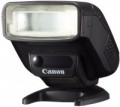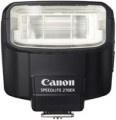Pulse duration
The duration of the pulse of light provided by the flash. This indicator can range from thousandths to hundred thousandths of a second; it is usually expressed as a fractional number with a unit in the numerator, such as 1/880 s. The human eye does not notice the difference, but in some shooting modes it can become critical. For example, to capture fast-moving scenes (such as splashing water, the flight of an insect, or the movement of machine parts) you need to choose a flash with the shortest flash duration possible — otherwise the image may be blurry.
The longest pulse duration in modern photoflashes is about 1/800 s; the minimum value can reach 1/30,000 s or even less.
TTL
Flash units with TTL support. TTL is an abbreviation for "through the lens", i.e. "through the lens"; this is the name of the method of measuring exposure by the amount of light that passes directly through the camera lens.
In digital photography, TTL works like a pre-flash: before the main exposure, the flash fires one or more test flashes. The amount of light coming from the object being filmed is measured by special sensors, based on these data, the control electronics sets the necessary shooting parameters, after which the actual exposure takes place. This allows you to fine-tune the camera and get an image of optimal quality. The interval between the test and operating pulses is so small that it may not be visible to the naked eye at all (especially when the flash is synchronized with the front curtain or with a slow shutter speed).
Many modern camera manufacturers have their own developments and varieties of TTL technology, respectively, differing in name: for example, Canon has E-TTL and E-TTL II, Nikon has D-TTL (in early models) and i-TTL (in later ones) , Pentax has P-TTL, etc. Support for one or another variety is directly related to the compatibility of the flash with cameras (see above), and different formats are usually not compatible with each other.
Power management
The ability to manually change the power of the light flux emitted by the flash (with a constant pulse duration, see above). This feature is present in most modern models; it allows you to set the optimal parameters for shooting, so as not to “overexpose” the frame.
The characteristics of models with power management usually indicate the levels to which it can be set. Traditionally, each next (in descending order) level corresponds to half the power than the previous one, and they are indicated by fractional numbers: 1/1 (full power), 1/2, 1/4, 1/8, etc. The features of flash power control depending on the shooting parameters are described in detail in special sources, however, anyway, the more setting levels, the more options you have for setting the optimal parameters. This is especially true for shooting at short distances, where the risk of excessive “flare” increases.
Features
—
Autofocus illuminator. The flash has an auxiliary illumination function for the camera's autofocus system. Modern cameras overwhelmingly use the so-called passive autofocus systems that have one serious drawback: very low efficiency in low light and/or low contrast of the object being shot. The autofocus illuminator is designed to solve this problem: before focus, the scene is illuminated by a separate lamp, placed, in this case, directly in the flash body. This provides enough light for normal autofocus operation. Most often, backlight lamps give light with a characteristic reddish tint, however, in some advanced models, infrared illumination is used — invisible to the eye, but perceived by the camera. In addition, illumination systems can use a special light pattern instead of a solid beam, which further simplifies the task of autofocus systems. Anyway, the presence of this function is especially relevant given the fact that the flash is often used as a light source in low light.
— Control on the camera. The ability to change the settings for the flash using the controls of the camera itself, to which it is connected. In some cases (for example, with a wireless connection), this is much more convenient than switching attention from the camera to the flash.
—
Automatic zoom. The ability to automatically change the angle of dispersion of the flash light. For the angle of dispersion,
...see the relevant paragraph above, but here we note that this function provides synchronization between the flash and the lens: when the focal length of the lens changes, the angle of dispersion automatically changes. This provides the most effective illumination of the scene and at the same time relieves you of the need to manually re-adjust the flash to a changed angle of view each time.
— Manual zoom. Possibility to change the flash spread angle (see "Light spread angle") manually. This function expands the possibilities for "fine" tuning of work parameters and allows you to set parameters that are not available with automatic zoom (see above). In addition, it will be useful if you have to use several prime lenses with different focal lengths — the flash can be easily adjusted to each of them.
— Wireless control. Ability to wirelessly connect the flash to the camera or to another flash as master/slave (if available, see below). The format and specific features of such a connection may be different: wired connection, IR channel, radio, etc. Wireless control is indispensable if the flash must be placed away from the camera; it also makes it easier to create multiple flash systems for optimum lighting. These features are especially useful for studio shooting (although it's not limited to this).
— Work in master mode. The ability to operate the flash as a master flash for a system of multiple flashes. The entire system is controlled through the master flash, the operation parameters of the slave flashes are set, and the command to fire is given (note that the master flash itself may not fire at all). If you plan to shoot using a multi-flash system, you will definitely need a model with this function — without it, creating a system is impossible. Of course, master and slave flashes must be mutually compatible; this point should be clarified separately.
— Work in slave mode. The ability to work as a flash as a slave in a system of several flashes. In this mode, the device is connected to the master flash and fires on command from it. For more information on flash systems, see "Master Operation" above.
— Diffuser. The colour of the diffuser supplied with the on-camera light source (see "Type"). Colour can be: orange, white, pink or yellow.
A diffuser is a special filter designed to scatter light from individual LEDs, and also, in some cases, to give it a certain colour and change the colour temperature.
— Radio synchronizer. A device designed to wirelessly control a flash or a set of flashes (if each has its own receiver). Usually a separate module installed in the hot shoe; on command to fire, this module sends a radio signal to all receivers tuned to it, ensuring synchronous flash firing. At the same time, some models of luminaires with such a function are capable of receiving via the radio channel not only the start signal, but also the operating parameters (primarily the duration and power of the pulse).
